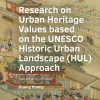Research on Urban Heritage Values based on the UNESCO Historic Urban Landscape (HUL) Approach
€ 19,95
The case study of Suzhou
Serie: A+BE Architecture and the Built Environment
Huang, Huang | Paperback / softback | 08-03-2024 | 9789463668361 |
Levertijd 5 dagen
As far as a historic city is concerned, a city is a dynamic complex which consists of many different interrelated and interac…





